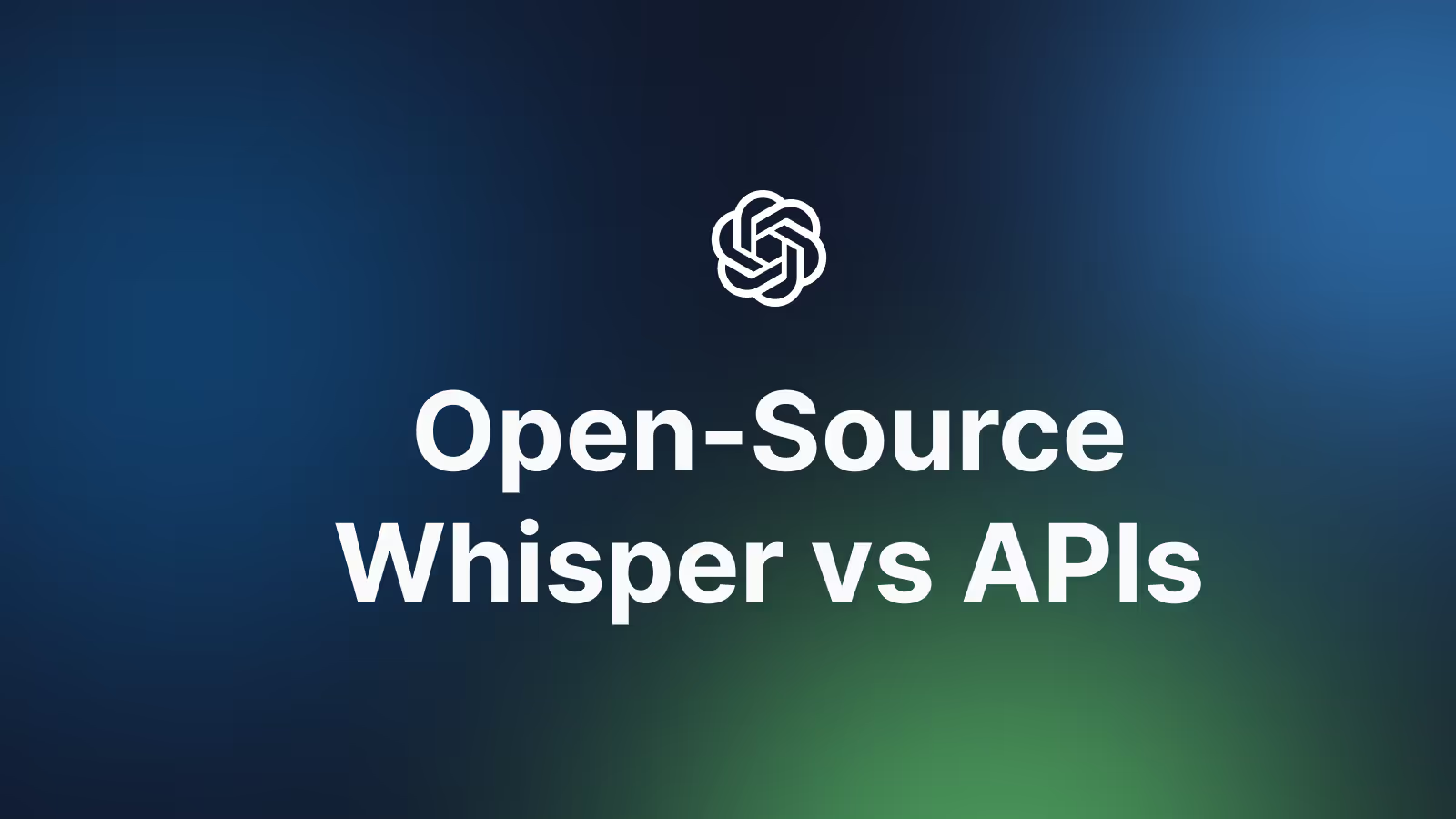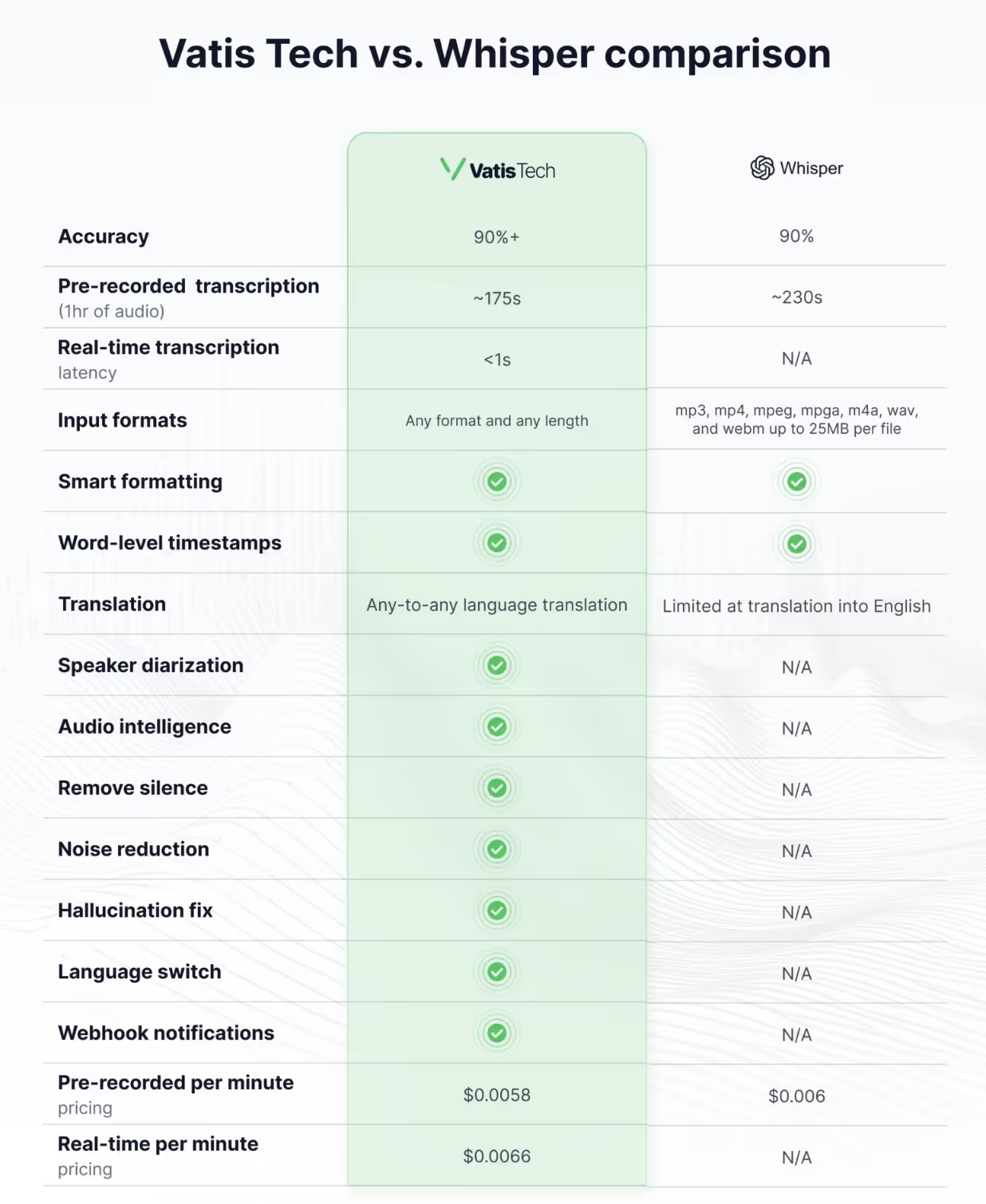TABLE OF CONTENTS
Experience the Future of Speech Recognition Today
Try Vatis now, no credit card required.
Choosing the right speech-to-text solution can be overwhelming—whether you're an AI enthusiast, a developer, or a business leader looking to optimize workflows. OpenAI’s Whisper has emerged as a flexible, open-source option, but is it the best choice for your needs? Or should you consider API-based alternatives that deliver real-time results without the overhead of managing infrastructure?
In this post, we’ll explore the benefits and limitations of using Whisper to build your own ASR (Automatic Speech Recognition) solution. We’ll also look at API-based alternatives and compare how each approach suits different business needs.
By the end, you’ll have a clearer idea of what’s right for you: Whisper or an ASR API.
Why Choose Whisper? The Power of Open-Source ASR
The open-source revolution in AI has made it easier than ever to build in-house solutions. A few years ago, setting up an ASR system required a team of specialists and a significant budget.
Today, platforms like GitHub and Hugging Face offer access to pre-trained models, so you can start building without developing everything from scratch.
Several open-source ASR models are available, including:
- Mozilla DeepSpeech: An open-source ASR model widely used in voice assistants and transcription services, known for its straightforward implementation and effectiveness.
- Kaldi: A flexible and modular toolkit often favored in research settings for its deep customization options. Kaldi has been successfully integrated into multiple commercial ASR systems.
- Wav2vec 2.0 (Facebook AI): An advanced model from Facebook AI Research that leverages self-supervised learning to achieve high accuracy on limited labeled data, making it particularly effective in low-resource scenarios.
- NeMo (NVIDIA): Part of NVIDIA’s open-source toolkit, NeMo provides pre-trained ASR models optimized for use on NVIDIA GPUs, with support for deep learning ASR and customization options for various languages and use cases.
- CMU Sphinx, Wav2Letter++, and Julius: These models each have distinct capabilities. CMU Sphinx is known for its flexibility, Wav2Letter++ focuses on speed and simplicity, and Julius is widely used in research due to its efficiency in embedded systems.
Key Benefits of Using Whisper
Among all open-source ASR systems, Whisper by OpenAI stands out for its accuracy and versatility. Released in 2022, Whisper uses deep learning and a transformer-based encoder-decoder architecture, similar to GPT-3.
- High Accuracy: Whisper boasts an accuracy rate of about 90%, even in challenging conditions.
- Multilingual Support: Whisper can transcribe in several languages, which is ideal for international projects.
- Open Source and Customizable: As an open-source model, Whisper can be modified and fine-tuned to meet your exact needs, offering unparalleled flexibility.
- Cost-Effective at First: Since there are no licensing fees, Whisper can seem like a cost-effective solution, especially for small teams or developers with technical expertise.
Whisper’s Hidden Challenges: What You Need to Know
While Whisper offers significant benefits, it's not without its drawbacks. These limitations can become especially pronounced as you scale or require more advanced features.
1. No Real-Time Transcription
Whisper is designed for batch processing and pre-recorded audio. It lacks real-time transcription capabilities, making it unsuitable for live customer support, media broadcasts, or legal use cases requiring immediate transcription.
2. High Resource Requirements
Running Whisper is resource-intensive. The model’s largest version, Large-v3, demands significant GPU power and memory to run effectively. As a result, scaling up to handle larger transcription volumes can be costly in terms of infrastructure.
3. Limited Features
Whisper doesn't offer advanced features like:
- Speaker Diarization: The ability to separate speakers in a conversation.
- Noise Reduction: Filtering out background noise to improve transcription accuracy.
- PII/PCI redaction for enhanced data security and anonymization.
These features are often required in professional environments, and their absence means developers would need to implement them separately.
4. File Size Limitations
Whisper has a file size cap of 25MB per audio file, requiring developers to split large audio files into smaller chunks. This adds complexity to the workflow, especially when handling long recordings or media files.
5. Total Cost of Ownership (TCO)
Although Whisper is open-source, the cost of maintaining it over time can escalate quickly. To run Whisper at scale, you’ll need to invest in powerful hardware, hire AI specialists, and manage ongoing server costs. For businesses transcribing hundreds of hours of audio each month, the costs can easily exceed $300k annually.
This article provides detailed insights into the costs involved in hosting OpenAI Whisper in-house.
Is Whisper the Right Fit? A Strategic Evaluation
So, is Whisper the right choice for your business? It depends on your specific needs.
- For Developers and Researchers: Whisper is an excellent tool for experimentation and fine-tuning. If you’re building a custom application and have the necessary AI expertise, Whisper’s flexibility is hard to beat.
- For Startups: Whisper may seem cost-effective at first, but scaling it for production comes with significant infrastructure costs. If your transcription needs grow, so will your expenses.
- For Enterprises: If you need real-time transcription, seamless integration, or advanced features like speaker diarization, Whisper may not be sufficient. The hidden costs of infrastructure and maintenance can become a burden, pulling your team away from core business activities.
Exploring Another Path: The Advantages of Speech-to-Text APIs
APIs provide developers with a pre-built, cloud-based service to convert spoken language into written text. They eliminate the need to develop, maintain, or optimize an ASR system from scratch, significantly reducing your technical burden.
Open Source vs API: Which Solution Suits You Best?
Real-Time Transcription: Most API providers, including Vatis Tech, offer real-time transcription with sub-second latency, making them perfect for industries like media, customer service, and live events.
Scalability: With API solutions, you don’t need to worry about managing hardware or scaling infrastructure. The service provider handles all of that, allowing you to easily scale your transcription needs.
Advanced Features: API-based services often include essential features such as speaker diarization, noise reduction, smart formatting, and PII/PCI redaction for enhanced data security and anonymization, making them ideal for professional applications.
Low Total Cost of Ownership: Instead of investing in infrastructure and human capital, you pay for what you use with an API, often making it more cost-effective in the long term.
Fast Time-to-Market: APIs allow you to integrate ASR capabilities into your product quickly. You can get started in a matter of hours or days, compared to the months it might take to build an in-house solution with Whisper.
API Solutions vs. Whisper: Quick Comparison Table
Here’s a side-by-side comparison to help you decide between Whisper and an API solution.
Continue Reading

You’re not short on ideas. You’re short on time. Let Vatis handle the time part.
…or you could keep copying, pasting, editing, rewriting…








.avif)
